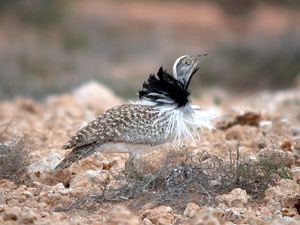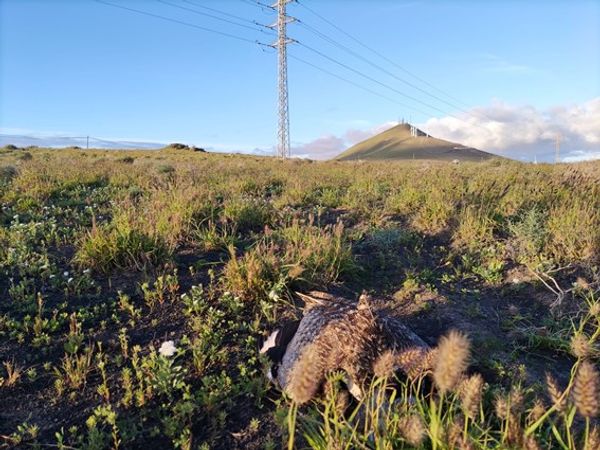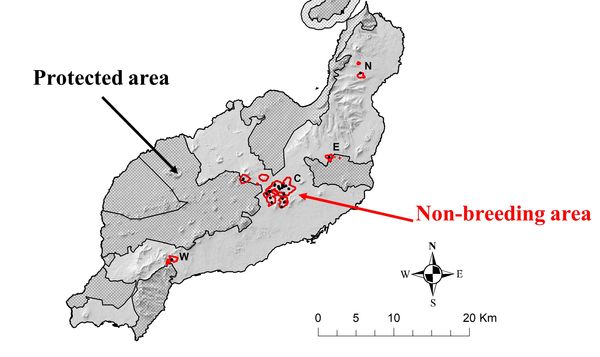 LINKED PAPER
LINKED PAPER
Short-distance nocturnal migration in an island endemic bustard. Abril-Colón, I., Alonso, J.C., Palacín, C., Álvarez-Martínez, J.M. & Ucero, A. 2022 Ibis. doi: 10.1111/ibi.13061 VIEW
Most migratory species are partial migrants, and typically fly long distances in response to large scale seasonal climate variation. However, some fly only short distances and, although the causes and details of these partial, short-distance migrations have scarcely been investigated, they may be fixed in populations as a result of evolutionarily adaptive responses to local habitat conditions. The movements of Houbara Bustards (Chlamydotis undulata) have been studied only in the North African subspecies C. u. undulata, but nothing is known about migratory movements of the Canarian subspecies C. u. fuertaventurae, which was thought to be sedentary.
Technological advances in wildlife tracking methods have enabled unprecedented accuracy in the study of animal behavior and movements. Using the latest generation of GSM/GPRS data loggers together with accelerometers, we were able to collect the first evidence of nocturnal and partial migration of Canarian Houbara Bustards, specifically in the island of Lanzarote, the main stronghold of this subspecies. This subspecies is classified as globally Vulnerable. It is restricted to the three easternmost islands of the archipelago: Lanzarote, Fuerteventura and La Graciosa. The study was carried out under a contract between Red Eléctrica de España and Consejo Superior de Investigaciones Científicas awarded to Prof. Juan C. Alonso.
More than one third of 41 tagged individuals moved from their breeding to non-breeding areas, where they spent the hottest months of the year. These results show that the partial migration patterns described for the nominate subspecies and for the MacQueen’s Bustard (C. macqueenii) have remained in the Canarian Houbaras despite of their much smaller geographic distribution. Most flights occurred at night, confirming the existence of nocturnal activity beyond sexual activity (Alonso et al. 2021).

Figure 1 A Canarian Houbara Bustard (Chlamydotis undulata fuertaventurae) flying over Lanzarote island © Inmaculada Abril-Colón.
Furthermore, the existence of protandry was confirmed, with migratory males returning to their breeding territories earlier than females. By arriving earlier, birds can start defending their territories earlier (rank advantage hypothesis), and have more opportunities to mate earlier in the season (mate opportunity hypothesis). Advantages of protandry for females include avoiding waiting for males to become established (waiting cost hypothesis) and being able to choose among a larger sample of males (mate choice hypothesis).
Using the Soil Adjusted Vegetation Index (SAVI) derived from Sentinel 2 imagery, a multispectral Copernicus satellite with 10 metres of spatial resolution and a revisit time of 5 days, we found that by moving to non-breeding areas migrants obtained a benefit in terms of habitat quality, while sedentary birds did not suffer any disadvantage by remaining within their territories. This suggests that partial migration has probably persisted in this populations due to the differences in food availability during summer across different areas.
Conservation implications

Figure 2 A deceased Houbara Bustard suspected to be caused by collision with a power line © Alberto Ucero.
Three important conclusions for conservation can be drawn from our study. First, the risk of collision with power and telephone lines is obviously higher during nocturnal flights. Thus, burying lines is the only feasible way to eliminate this mortality.

Figure 3 All non-breeding sites of migrant Houbara Bustards (7 males, 17 females) were outside Special Protection Areas for birds (SPA) in Lanzarote island (grey grids).
Second, we discovered a clear preference for one particular non-breeding area, and the explanation seems to be the mosaic of Launaea arborescens shrubland and irrigated farmland present in that area. This areas has an adequate amount and distribution of fallow fields, irrigated cultivated fields, and non-cultivated shrubland patches. Finally, none of the known non-breeding areas are legally protected. Considering the time Houbara Bustards spend at these areas over their annual cycle, and their importance for the species during summer, some kind of legal protection might help ensure that land-use conditions are maintained in a way that safeguards the species.
References
Alonso, J.C., Abril-Colón, I. & Palacín, C. 2021. Moonlight triggers nocturnal display in a diurnal bird. Animal Behaviour 171: 87-98. VIEW
Image credit
Top right: Houbara Bustard © Len Worthington CC BY SA 2.0 Wikimedia Commons.
If you want to write about your research in #theBOUblog, then please see here.




